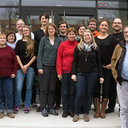Sesquiterpene amino ether and cytotoxic phenols from Dendrobium wardianum Warner.
Atslēgvārdi
Abstrakts
A new bibenzyl derivative, dendrocandin V (1) and a new sesquiterpene amino ether, wardianumine A (2), together with eleven known compounds, including phenanthrenes (denbinobin (3), 9,10-dihydro-denbinobin (4), mostatin (5), loddigesiinols A (6)), bibenzyls (moscatilin (7), 5-hydroxy-3,4'-dimethoxybibenzyl (8), 3,4-dihydroxy-5,4'-dimethoxy bibenzyl (9), dendrocandin A (10), gigantol (11), dendrocandin U (12)) and an alkaloids (dihydroshihunine, 13) were isolated from the EtOH extraction of stems of Dendrobium wardianum Warner. Isolation of the new compound 2 indicated that N,N-dimethylethanolamine as the key adduction in the synthesis of dendroxine and its analogs in Dendrobium species. The hypothetical biosynthetic pathway of 2 was then postulated. Inspired by literature and traditional usage of the herbal medicine, some compounds were sent for cytotoxic activity and the results indicated that compounds 1, 3, 4, 5 showed cytotoxic activities against five human cancer cell lines (HL-60, A-549, SMMC-7721, MCF-7, and SW-480) with IC50 from 2.33-38.48μM. Among those compounds, 3 and 4 showed cell line selectivity with strong activity comparable to DDP.





